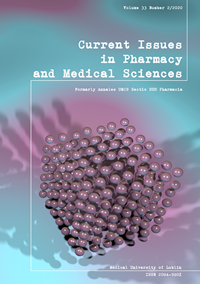Microbiological purity of syringes containing composites in the context of cross-infection prevention in dental practices
DOI:
https://doi.org/10.2478/cipms-2020-0019Keywords:
cross-infection, microbiological contamination, dental materialsAbstract
Cross-infection involves the transmission of microorganisms through secretions, bodily fluids and excreta, as well as undisinfected surfaces and medical equipment. In the dental office, diseases are transmitted via various routes, e.g. from patient to dentist or other member of dental team, from doctor or dental team member to patient, from patient to another patient, from dental office to community and from community to patient. The study was conducted to evaluate the effectiveness of infection control in dental practices based on the qualitative and quantitative assessment of microbiological contaminants detected on the surface of filling material packaging used in dental offices. The material for research were 9 packages containing dental materials during their use in 3 dental settings. The packages were placed in sterile flasks and rinsed to wash microorganisms from the surfaces. The washes were filtered through membrane filters and cultured under proper aerobic and anaerobic conditions, and at elevated CO2 concentration. Microbial growth on TIO and TSB media was observed. The contamination of most samples remained low as indicated by the growth from one to a maximum of five colonies on TSA. The contamination remained at the level of 10-50 CFU/package, i.e. <100 CFU/single package. The tests evaluating the contamination of dental package surfaces with aerobic bacteria confirmed high hygiene standards observed in dental offices from which the packages were brought.
References
1. Miller CH, Palenik CJ, Jkan B, Altay MA. Infection control andmanagement of hazardous materials for the dental team, 3rd ed 10 infectious disease and personal protection techniques for infection control in dentistry. J Dent Med Sci. 2017;16(04):126-41.
2. Kohli A, Puttaiah R. Dental infection control and occupational safety for oral health care professionals Australian Dental Association. Guidelines for Infection Control, Second Edition, 2012.
3. Baseer MA, Rahman G, Yassin MA. Infection control practices in dental school: a patient perspective from Saudi Arabia. DRJ (Isfahan). 2013;10:25-30.
4. Laheij AMGA, Kistler JO, Belibasakis GN, Välimaa H, de Soet JJ. Healthcare-associated viral and bacterial infections in dentistry. European Oral Microbiology Workshop (EOMW) 2011 J Oral Microbiology. 2012;4:17659.
5. John M. Risk of bacterial transmission in dental practice. J C an Dent Assoc. 2000;66:550-2.
6. Westall JO, Dickinson C. Compliance with occupational exposure risk management procedures in a dental school setting. British Dental Journal. 2017;222(11):859-63.
7. Samaranayake LP. Rules of infection control. IDJ. 1993;43(6):578-84.
8. Almeida JCF, Prado AKS, Silva WC, Wértina C, Pedrosa SF, Moura MAO, Lopes LG. Contamination of composite resins in dental offices. ROBRAC. 2010;19:211-5.
9. Batista ME, Gomes PS, Freitas MRLS, Alvaez-Leite ME. Evaluation of microbiological contamination of tubes of composite resin, syringes of acid and fur brushes used in different dental restorations. Revista de Odontologia da Universidade Cidade de São Paulo. 2013;25;115-25.
10. Pauletti NA, Girotto LPS, Leite FHS, Mario DN. Effect of photoactivation on the reduction of composite resin contamination. EJOS. 2017;125(3):223-6.
11. Oliveira M, Barreto RM, Salgado IO, Chaves Filho HDM, Diniz CG. Evaluation of bacterial contamination in composite resins used at graduation clinics of FO-UFJF. Odontol ClínCient. 2010;9(1):73-6.
12. Ranali J, Ramacciato JC, Motta RHL. Biossegurança na sedação inalatória com óxido nitroso e oxigênio. APCD. 2004;58(5):374-8.
13. Ferreira RO, Caires NCM. Avaliação da contaminação dos tubos de resina composta nas clínicas do Curso de Odontologia de uma universidade partículas em Manaus - AM. J Health Sci Inst. 2012;30(3):206-10.
14. Aleixo RQ, Queiroz RC, Custódio VC, Moura JA. Contaminação dos tubos de resina composta utilizados na clínica odontológica. Clínica e Pesquisa em Odontologia - UNITAU. 2010;2(1):39-45.
15. Cardoso CT, Pinto JR. Junior, Pereira EA, Barros LM, Freitas ABDA. Contaminação de tubos de resina composta manipulados sem barreira de proteção. ROBRAC. 2010;19(48).
16. Silva CRG, Jorge AOC. Evaluation of surface disinfectants utilized in dentistry. Pesquisa Odontológica Brasileira. 2002;16(2):107-14.
Downloads
Published
Issue
Section
License
Copyright (c) 2020 Authors

This work is licensed under a Creative Commons Attribution-NonCommercial-NoDerivatives 3.0 Unported License.


